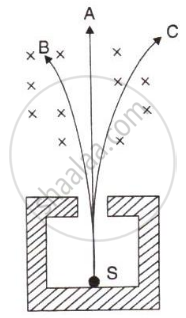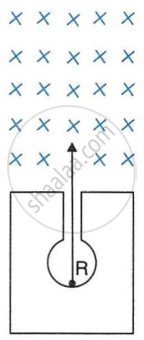Advertisements
Advertisements
प्रश्न
The diagram in figure shows a radioactive source S placed in a thick lead walled container. The radiations given out are allowed to pass through a magnetic field. The magnetic field (shown as ×) acts perpendicular to the plane of paper inwards. Arrows shows the paths of the radiation A, B and C.

- Name the radiations labelled A, B and C.
- Explain clearly how you used the diagram to arrive at the answer in part (a).
उत्तर
- The radiations are-
- A → γ radiation
- B → α radiation
- C → β radiation
-
- The radiation labelled as A pass undeviated which means that they are uncharged (or neutral) so they must be γ radiations.
- The radiation labelled as B turn to the left which means that they are positively charged so they must be α radiations.
- The radiation labelled as C turn to the right which means that they are negatively charged so they must be β radiations.
APPEARS IN
संबंधित प्रश्न
A radioactive source emits three types of radiations.
Name the three radiations.
A radioactive source emits three types of radiations.
Name the radiations which are deflected by the electric field.
In following Figure shows a mixed source R of alpha and beta particles in a thick lead walled container. The particles pass through a magnetic field in a direction perpendicular to the plane of paper inwards as shown by ×.
- Show in the diagram how the particles get affected.
- Name the law used in part (a).

[Hint: Alpha particles will deflect to the left while beta particles to the right]
Arrange the α, β, and γ raditions in ascending order of their ionising powers.
State the speed of each of α, β and γ radiations.
What is the composition of α, β and γ radiations?
Compare the penetrating powers of α, β and γ-radiations.
Compare the ionising powers of α, β and γ radiations.
What are α-and β-radiations?
A beam of α, β and γ rays is travelling through a certain region in space.
- Arrange them in ascending order of ionising power.
- Which of the above will pass undeviated if subjected to an electric field?
- With respect to your answer to part (b) above, what will be the change in the nucleus of an atom after such a ray is emitted.
